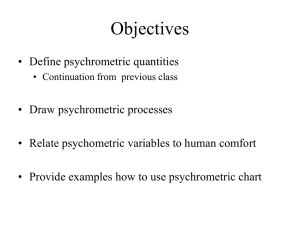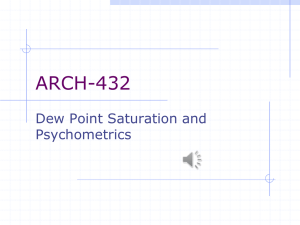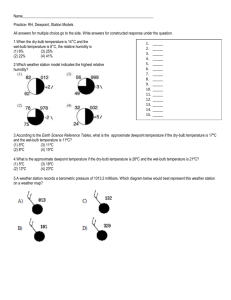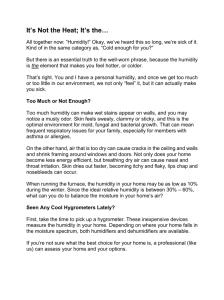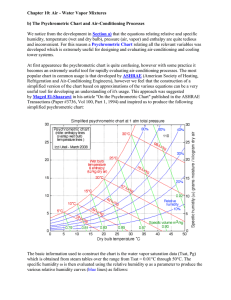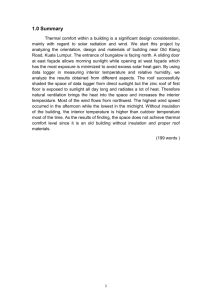346N_No02_HVAC_comfort
advertisement
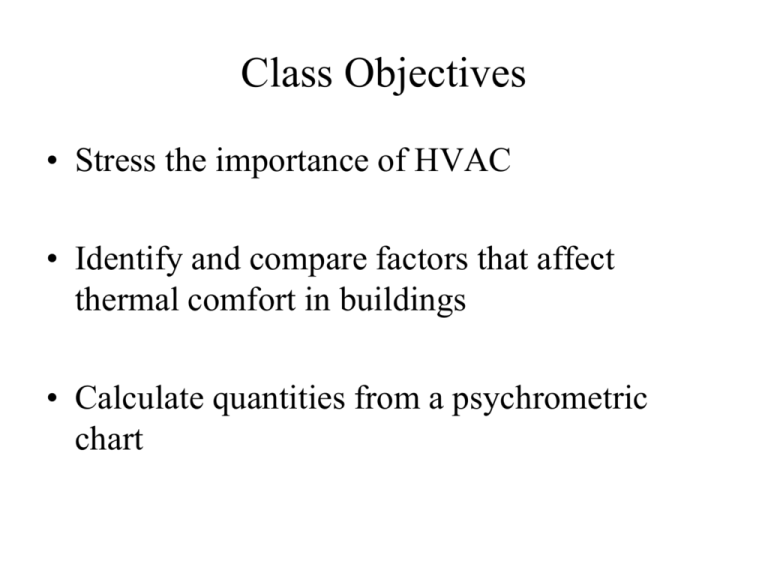
Class Objectives • Stress the importance of HVAC • Identify and compare factors that affect thermal comfort in buildings • Calculate quantities from a psychrometric chart HVAC Affects: • • • • • Energy use (outdoor air quality) Peak demand Indoor air quality Occupant comfort and productivity Building cost Primary energy vs. End use energy 1kWh (3.6MJ) of source energy (fuel) ≠ 1kWh of electric energy • End use energy amount of energy delivered to consumer electric, heating, cooling • Primary energy amount of energy delivered to consumer + energy sources used to produce this energy Example: conversion and transmission losses in power plant and delivery systems Energy efficiency vs. Thermal efficiency Heating the residential house Power plant 100% Primary energy (gas) Energy efficiency 33% Transport 100% Primary energy (gas) Energy efficiency 73% ~ 33% Electric energy ~ 97% Gas energy Electric heater Furnace heater Thermal efficiency 100% End use ~ 33% For heating Thermal efficiency 75% End use ~73% For heating Page 17 Tao and Janis LEED – Leadership in Energy and Environmental Design • Green building rating system • High-performance and sustainable buildings • Voluntary (at this moment) national standard Affect • • • • • • Location environment – sustainable site Use of energy Use of water resources Use of building materials IAQ Design process Thermal Comfort • Combination of - Indoor environmental factors - Personal factors • Human body - in thermal equilibrium with the environment Thermal comfort equation - P.O.Fanger Energy balance for human body Metabolic Heat - Work = Energy that body release Thermal comfort • • • • • • Metabolism – health condition and activity Clothing level Air Temperature Mean Radiant Temperature Air Velocity Humidity P.O. Fanger PPD – Predicted Percentage of Dissatisfied Scale 5-100% Thermal comfort Factors that we control in buildings • • • • Air Temperature Humidity Air velocity Surrounding Temperature Overview • Psychrometric quantities • Heat loss and gain • Cooling, heating, and ventilation loads • Cooling and heating equipment • Air equipment and controls Willis Haviland Carrier - Carrier 1911 "Rational Psychrometric Formulae” Psychrometric Chart • Need two quantities for a state point • Can get all other quantities from a state point • Can do all calculations without a chart • Often require iteration • Many “digital” psychrometric charts available • Can make your own • Best source is ASHRAE Fundamentals (Chapter 6) Temperature • • • • Absolute Temperature (T) (K, R) Dry-bulb temperature (t) [°F, °C] Wet-bulb temperature (t*) Dew-point temperature (td) • Mean radiant temperature (tr) • Operative temperature (to) • Effective temperature (ET*) Which temperature do you expect to be higher? A. Wet-bulb B. Dry-bulb Wet-bulb temperature (t*) • Temperature measured by a psychrometer • Lower than dry-bulb temperature • Evaporating moisture removes heat from thermometer bulb • The higher the humidity • Smaller difference between wet-bulb and dry-bulb temperature Dew-Point Temperature, td • Define temperature at which condensation happen • td is defined as temperature of that air at saturation • i.e. RH = 100% • Surfaces below the dew point temperature will have condensation • Measured with a chilled-mirror apparatus If you have a sample of air at its dew-point temperature? A. The water will condense out. B. It will be pure water vapor. C. Putting the sample in a sealed container and heating it will cause condensation. D. Putting the sample in sealed container and cooling it will cause condensation. Humidity • Humidity ratio (W) [lb/lb, g/kg, grains] [grains/lb = 1/7000 lb/lb] • Relative humidity (RH, ) [%] • Saturation Humidity Ratio, W • Mass of water vapor/divided by mass of dry air • Orthogonal to temperature • Not a function of temperature • Most convenient form for calculations involving airflow • Very hard to measure directly Relative Humidity, RH or • Ratio of partial pressure of water vapor to partial pressure of water vapor at same T and P at saturation • Strong function of temperature • For constant humidity ratio • Higher temperature, lower relative humidity • Saturation Relative Humidity • Driving force for moisture transport • Human comfort • Moisture absorption/desorption • Can be measured with • Resistive sensors • Capacitive sensors • Horse hair Conclusions • Define thermal comfort parameters • Define all quantities on a psychrometric chart and use it to do calculations Reading Assignment Chapter 1 and Chapter 2 (Section 2.1 & 2.2) Tao and Janis Next class – Thursday 5 minutes quiz at the beginning of the class

